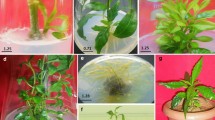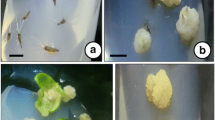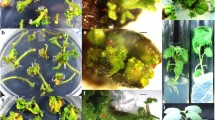Abstract
Hedychium coronarium J. Koenig is a rhizomatous herb (Zingiberaceae family) and is well known for its uses in traditional systems of medicine for the treatment of various diseases. The plant has been over-exploited and enlisted as a threatened species in India. Thus, there is an urgent attention required for its conservation. Here, a callus-mediated in vitro plant regeneration protocol was developed using leaf sheath of H. coronarium. The optimal medium for callus induction (85.0%) and subsequent proliferation was found to be MS basal medium augmented with 3.0 mg L−1 N6-benzyladenine (BA), 0.5 mg L−1 α-naphthaleneacetic acid (NAA), and 3.0% sucrose, and gelled with 0.5% agar. Optimum callus-mediated shoot organogenesis (78.3%; ca. 11.4 shoots/0.5 g of callus) was obtained on MS medium supplemented with 3.0 mg L−1 BA after 6 wk of culture. All the in vitro regenerated shoots were rooted (8.5 roots/shoot) successfully on plant growth regulator–free MS medium. About 90% plantlets were acclimatized on the planting tray filled with garden soil and sand (1:1). Transfer of these plants to larger pots containing garden soil and subsequent field transfer under full sun resulted in cent-percent survival. Monomorphic banding profile obtained using Random Amplified Polymorphic DNA (RAPD) and Inter Simple Sequence Repeat (ISSR) markers ascertained the clonal fidelity of the in vitro regenerated plants. Similarly, the biochemical fidelity of the in vitro regenerated plants vis-à-vis mother plant was ascertained by comparing the composition of essential oil through gas chromatography/mass spectrometry (GC/MS) analysis. Furthermore, the antioxidant activities estimated by DPPH and ABTS free radical scavenging assay and anticancer activities evaluated against two cell lines, i.e., MCF 7 and MDA-MB 231, also confirmed comparable effectiveness of in vitro regenerated plants to that of the mother plant. Thus, the study has the potential to provide a platform to achieve sustainability by using the in vitro regenerated H. coronarium in place of naturally available population.







Similar content being viewed by others
Data Availability
All data generated or analyzed during this study are included in this published paper.
References
Amoo SO, Aremu AO, Van Staden J (2012) In vitro plant regeneration, secondary metabolite production and antioxidant activity of micropropagated Aloe arborescens Mill. Plant Cell Tiss Org Cult 111(3):345–358
Anjusha S, Gangaprasad A (2016) Callus culture and in vitro production of anthraquinone in Gynochthodes umbellata (L.) Razafim. & B. Bremer (Rubiaceae). Ind Crop Prod 95:608–614
Auer CA, Cohen JD (1993) Identification of a benzyladenine disaccharide conjugate produced during shoot organogenesis in Petunia leaf explants. Plant Physiol 102:541–545
Babu KN, Samsudeen K, Divakaran M, Pillai GS, Sumathi V, Praveen K, Ravindran PN, Peter KV (2016) Protocols for in vitro propagation, conservation, synthetic seed production, embryo rescue, microrhizome production, molecular profiling, and genetic transformation in ginger (Zingiber officinale Roscoe.). In: Jain SM (ed) Protocols for in vitro cultures and secondary metabolite analysis of aromatic and medicinal plants, second edition, Methods in Molecular Biology, vol 1391. Springer, New York, pp 403–425
Bailly C (2020) Anticancer activities and mechanism action of the labdane diterpene coronarin D. Pathol Res Pract 216(6):152946
Behera S, Chouhan VBS, Pati K, Bansode VV, Nedunchezhiyan M, Verma AK, Monalisa K, Naik PK (2022a) Biology and biotechnological aspect of sweet potato (Ipomoea batatas L.) a commercially important tuber crop. Planta 256:40
Behera S, Kamila PK, Rout KK, Barik DP, Panda PC, Naik S (2018a) An efficient plant regeneration protocol of an industrially important plant, Hedychium coronarium J. Koenig and establishment of genetic and biochemical fidelity of the regenerants. Ind Crop Prod 126:58–68
Behera S, Kar SK, Rout KK, Barik DP, Panda PC, Naik SK (2019) Assessment of genetic and biochemical fidelity of field established Hedychium coronarium J. Koenig regenerated from axenic cotyledonary node on meta-topolin supplemented medium. Ind Crop Prod 134:206–215
Behera S, Monalisa K, Meher RK, Mohapatra S, Das PK, Madkami SK, Naik PK, Naik SK (2022b) Phytochemical fidelity and therapeutic activity of micropropagated plant Curcuma amada Roxb.: an important medicinal herb. Ind Crop Prod 176:11440
Behera S, Rath S, Akhtar MS, Naik SK (2018b) Biotechnological intervention through tissue culture in Hedychium coronarium: a potential anticancer plant. In: Akhtar MS, Swamy MK (eds) Anticancer plants: natural products and biotechnological implements Vol 2 Springer. Singapore
Behera S, Rout KK, Panda PC, Naik SK (2020) Production of non-embryogenic synthetic seeds for propagation and germplasm transfer of Hedychium coronarium J. Koenig. J Appl Res Med Aromat Plants 19:100271. https://doi.org/10.1016/j.jarmap.2020.100271
Borah A, Paw M, Gogoi R, Loying R, Sarma N, Munda S, Pandey SK, Lal M (2019) Chemical composition, antioxidant, anti-inflammatory, anti-microbial and in vitro cytotoxic efficacy of essential oil of Curcuma caesia Roxb. leaves: an endangered medicinal plant of North East India. Ind Crop Prod 129:448–454
Bruna S, Lauro B, Francisco M, Adriano B, Bruno K, Paulo O, Palimecio G (2010) Composition of leaf and rhizome essential oils of Hedychium coronarium Koen. Brazil J Essent Oil Res 22:305–306
Casanova E, Moysset L, Trillas MI (2008) Effect of agar concentration and vessel closure on the organogenesis and hyperhydricity of adventitious carnation shoots. Biol Plant 52:1–8
Chadha S (2005) Vulnerable and threatened plants of economic value. Hedychium coronarium (J.) Koenig. MFP News 15:19–20
Chan EWC, Wong SK (2015) Phytochemistry and pharmacology of ornamental gingers, Hedychium coronarium and Alpinia purpurata: a review. J Integr Med 13:368–379
Chen JC, Hsieh MC, Lin SH, Lin CC, His YT, Lo YS, Chuang YC, Hsieh MJ, Chen MK (2017) Coronarin D induces reactive oxygen species-mediated cell death in human nasopharyngeal cancer cells through inhibition of p38 MAPK and activation of JNK. Oncotarget 8:108006–108019
Costa RO, Vieira BH, Espindola ELG, Ribeiro AI, Ferro JLR, Fernandes JB, da Silva Matos DM (2021) Toxicity of rhizomes of the invasive Hedychium coronarium (Zingiberaceae) on aquatic species. Biol Invasions 23:2221–2231
da Silva CF, Petro RR, Almedida RN, Cassel E, Vargas RMF (2021) On the production and release of Hedychium coronarium essential oil from nano formulations. Ind Crop Prod 171:113984
Debergh P (1983) Effects of agar brand and concentration on tissue culture medium. Physiol Plant 9:270–276
Doyle JJ, Doyle JL (1990) Isolation of plant DNA from fresh tissue. Focus 12:13–15
Gomez KA, Gomez AA (1984) Statistical procedure for agricultural research, 2nd edn. John Wiley and Sons, New York
Gutteridge JMC, Halliwell B (2000) Free radicals and antioxidants in the year 2000 - a historical look to the future. Ann New York Acad Sci 899:136–147
Hussain MS, Fareed S, Ansari S, Rahman MA, Ahmad IZ, Saeed M (2012) Current approaches toward production of secondary plant metabolites. J Pharm Bioallied Sci 4(1):10–20
Ibrahim DA, Danial GH, Mosa VM, Khalil BM (2015) Plant regeneration from shoot tips derived callus of Ginger (Zingiber officinale Rosc). Am J Exp Agric 7(1):55–61
Jayaraman S, Daud NH, Halis R, Mohamed R (2014) Effects of plant growth regulators, carbon sources and pH values on callus induction in Aquilaria malaccensis leaf explants and characteristics of the resultant calli. J For Res 25(3):535–540
Jose S, Thomas TD (2015) High-frequency callus organogenesis, large-scale cultivation and assessment of clonal fidelity of regenerated plants of Curcuma caesia Roxb., an important source of camphor. Agrofor Syst 89:779–788
Joy B, Rajan A, Abraham E (2007) Antimicrobial activity and chemical composition of essential oil from Hedychium coronarium. Phytother Res 21:439–443
Kaur K, Dolker D, Behera S, Pati PK (2022) Critical factors influencing in vitro propagation and modulation of important secondary metabolites in Withania somnifera (L.) Dunal. Plant Cell Tiss Org Cult 149:41–60
Lata H, Chandra S, Techen N, Khan IA, El-Sohly MA (2016) In vitro mass propagation of Cannabis sativa L.: a protocol refinement using novel aromatic cytokinin meta-topolin and the assessment of eco-physiological, biochemical, and genetic fidelity of micropropagated plants. J Appl Res Med Aromat Plant 3(1):18–26
Li RH, Fan YP (2007) Changes in floral aroma constituents in Hedychium coronarium (J.) Koenig during different blooming stages. Plant Physiol Commun 43:176–180
Li Z, Gong M, Yang S, Long W (2012) Efficient callus induction and indirect plant regeneration from tissues of Jatropha curcas. Afr J Biotechnol 11(31):7843–7849
Lin HW, Hsieh MJ, Yeh CB, Hsueh KC, Hsieh YH, Yang SF (2018) Coronarin D induces apoptotic cell death through the JNK pathway in human hepatocellular carcinoma. Environ Toxicol 33(9):946–954
Liu YT, Hsieh MJ, Lin JT, Chen G, Lin CC, Lo YS, Chuang YC, Hsi YT, Chen MK, Chou MC (2019) Coronarin D induces human oral cancer cell apoptosis though upregulate JNK1/2 signalling pathway. Environ Toxicol 34:513–520
Mallon R, Oubina JR, Gonzalez ML (2010) In vitro propagation of the endangered plant Centaurea ultreiae: assessment of genetic stability by cytological studies, flow cytometry and RAPD analysis. Plant Cell Tiss Org Cult 101:31–39
Mohanty P, Behera S, Swain SS, Barik DP, Naik SK (2013) Micropropagation of Hedychium coronarium J. Koenig through rhizome bud. Physiol Mol Biol Plant 19(4):605–610
Murashige T, Skoog F (1962) A revised medium for rapid growth and bioassays with tobacco tissue cultures. Physiol Plant 15:473–497
Naik SK, Chand PK (2011) Tissue culture-mediated biotechnological intervention in pomegranate: a review. Plant Cell Rep 30:707–721
Naik PM, Manohar H, Praveen N, Murthy HN (2010) Effects of sucrose and pH levels on in vitro shoot regeneration from leaf explants of Bacopa monnieri and accumulation of bacoside A in regenerated shoots. Plant Cell Tiss Org Cult 100:235–239
Panigrahy SK, Kumar A, Bhatt R (2017) Antioxidant potentials of successive solvent extracts from the unexplored Hedychium coronarium rhizome. J Food Sci Technol 54(10):3297–3306
Parida R (2018) Coronarin D production from tissue cultured plantlets of Hedychium coronarium. J Biol Act Prod Nat 8(3):162–170
Parida R, Mohanty S, Nayak S (2015) Retention of drug yielding potential of micropropagated Hedychium coronarium. Biologia 70(1):34–38
Purkayastha J, Sugla T, Paul A, Solleti SK, Mazumdar P, Basu A, Mohommad A, Ahmed Z, Sahoo L (2010) Efficient in vitro plant regeneration from shoot apices and gene transfer by particle bombardment in Jatropha curcas. Biol Planta 54:13–20
Raju CS, Kathiravan K, Aslam A, Shajahan A (2013) An efficient regeneration system via somatic embryogenesis in mango ginger (Curcuma amada Roxb.). Plant Cell Tiss Org Cult 112(3):387–393
Ramsay JL, Galitz DS (2003) Basal medium and sucrose concentration influence regeneration of Easter lily in ovary culture. Hort Sci 38(3):404–406
Rao K, Chodisetti B, Gandi S, Mangamoori LN, Giri A (2011) Direct and indirect organogenesis of Alpinia galanga and the phytochemical analysis. Appl Biochem Biotechnol 165:1366–1378
Rather MA, Dar BA, Dar MY, Wani BA, Shah WA, Bhat BA, Ganai BA, Bhat KA, Anand R, Qurishi MA (2012) Chemical composition: antioxidant and antibacterial activities of the leaf essential oil of Juglans regia L. and its constituents. Phytomedicine 19:1185–1190
Ray A, Jena S, Dash B, Kar B, Halder T, Chatterjee T, Ghosh B, Panda PC, Nayak S, Mohapatra N (2018) Chemical diversity, antioxidant and antimicrobial activities of the essential oils from Indian populations of Hedychium coronarium Koen. Ind Crop Prod 112:353–362
Salvi ND, George L, Eapen S (2001) Plant regeneration from leaf base callus of turmeric and Random Amplified Polymorphic DNA analysis of regenerated plants. Plant Cell Tiss Org Cult 66:113–119
Selby C, Lee R, Harvey BMR (1989) The effect of culture medium rigidity on adventitious bud production and tissue vitrification in needle cultures of sitka spruce [Picea sitchensis (Bong.) Carr.]. New Phytol 113:203–210
Solanky RU, Patel SR, Patel JR (2013) In vitro regeneration of ginger (Zingiber officinale Rosc.) through callus culture. AGRES 2(2):196–202
Stanly C, Bhatt A, Ali HMD, Keng CL, Lim BP (2011) Evaluation of free radical scavenging activity and total phenolic content in the petiole derived callus cultures of Zingiber zerumbet Smith. J Med Plant Res 5(11):2210–2217
Suthar RK, Habibi N, Purohit SD (2011) Influence of agar concentration and liquid medium on in vitro propagation of Boswellia serrata Roxb. Indian J Biotechnol 10:224–227
Taha HS, Abbas MS, Aly UI, Gaber EI (2013) New aspects for callus production, regeneration and molecular characterization of ginger (Zingiber officinale Rosc). Med Aromat Plant 2(6):1–8
Tavares WR, Barreto MC, Seca AML (2020) Uncharted source of medicinal products: the case of the Hedychium genus. Medicines 7(23):1–23
Ved DK, Kinhal GA, Ravi Kumar K, Vijaya Shankar R, Sumathi R, Mahapatra AK, Panda PC (Eds.) (2008) Conservation assessment and management prioritization for medicinal plants of Orissa. Regional Plant Research Centre and Foundation for Revitalization of Local Health Traditions, Bhubaneswar and Bangalore
Verma M, Bansal YK (2013) Effect of additives on plant regeneration in Hedychium coronarium J. Koenig, an endangered aromatic and medicinal herb. Int J Pharm Sci Rev Res 23(1):105–110
Verma M, Bansal YK (2014) Effect of a potent cytokinin thidiazuron (TDZ) on in vitro regeneration of Hedychium coronarium J. Koenig- a valuable medicinal plant. Int J Rec Biotechnol 2(1):38–44
Zhou H, Liu J, Chen Z (2020) Coronarin D suppresses proliferation, invasion and migration of glioma cells via activating JNK signalling pathway. Pathol Res Pract 216:152789
Zhou Y, Wei X, Abbas F, Yu Y, Yu R, Fan Y (2021) Genome-wide identification of simple sequence repeats and assessment of genetic diversity in Hedychium. J Appl Res Med Aromat Plants 24:100312
Acknowledgements
SKN acknowledges the Science and Technology Department, Government of Odisha, for funding the work. This work was also supported by Science and Technology Department, Govt. of Odisha, and OHEPEE, Govt. of Odisha (through World Bank under Center of Excellence in Natural Products and Therapeutics) in the form of fellowship to SKB. Funding to the Center of Excellence in Environment and Public Health by Higher Education Department, Government of Odisha, under OHEPEE (HE-PTC-WB-02017) is also acknowledged by SKN.
Author information
Authors and Affiliations
Contributions
SB and SKN conceptualized the study, designed the entire experiment, and wrote the paper. SB and KM carried out all the tissue culture experiments, data collection, and analysis. DPB analyzed the tissue culture data along with SB and KM. PCP guided the RAPD and ISSR experiments carried out by SB and SKK. GC/MS analysis was carried out by SB and SM. PKN guided anticancer activity studies carried out by SB and RKM. SKN supervised the entire research and edited the manuscript to the final version. All the authors read and approved the final version of the manuscript.
Corresponding author
Ethics declarations
Conflict of interest
The authors declare no competing interests.
Supplementary information
Below is the link to the electronic supplementary material.
Rights and permissions
Springer Nature or its licensor (e.g. a society or other partner) holds exclusive rights to this article under a publishing agreement with the author(s) or other rightsholder(s); author self-archiving of the accepted manuscript version of this article is solely governed by the terms of such publishing agreement and applicable law.
About this article
Cite this article
Behera, S., Kar, S.K., Monalisa, K. et al. Assessment of genetic, biochemical fidelity, and therapeutic activity of in vitro regenerated Hedychium coronarium. In Vitro Cell.Dev.Biol.-Plant 59, 602–620 (2023). https://doi.org/10.1007/s11627-023-10383-z
Received:
Accepted:
Published:
Issue Date:
DOI: https://doi.org/10.1007/s11627-023-10383-z




